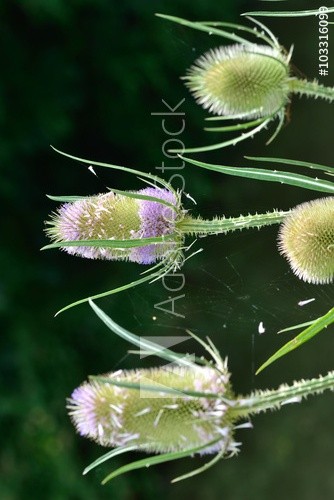Fuller's teasel
(Dipsacus laciniatus)

Description
Dipsacus fullonum, syn. Dipsacus sylvestris, is a species of flowering plant known by the common names wild teasel or fuller's teasel, although the latter name is usually applied to the cultivated variety D. fullonum var. sativus. It is native to Eurasia and North Africa, but it is known in the Americas, southern Africa, Australia and New Zealand as an introduced species. It is a herbaceous biennial plant (rarely a short-lived perennial plant) growing to 1–2.5 metres (3.3–8.2 ft) tall. The inflorescence is a cylindrical array of lavender flowers which dries to a cone of spine-tipped hard bracts. It may be 10 centimeters long. The genus name is derived from the word for thirst and refers to the cup-like formation made where sessile leaves merge at the stem. Rain water can collect in this receptacle; this may perform the function of preventing sap-sucking insects such as aphids from climbing the stem. The leaf shape is lanceolate, 20–40 centimetres (7.9–15.7 in) long and 3–6 centimetres (1.2–2.4 in) broad, with a row of small spines on the underside of the midrib. Teasels are easily identified with their prickly stem and leaves, and the inflorescence of purple, dark pink or lavender flowers that form a head on the end of the stem(s). The inflorescence is ovoid, 4–10 centimetres (1.6–3.9 in) long and 3–5 centimetres (1.2–2.0 in) broad, with a basal whorl of spiny bracts. The first flowers begin opening in a belt around the middle of the spherical or oval flowerhead, and then open sequentially toward the top and bottom, forming two narrow belts as the flowering progresses. The dried head persists afterwards, with the small (4–6 millimetres (0.16–0.24 in)) seeds maturing in mid-autumn. Carnivory in teasels was discussed by Francis Darwin (son of Charles Darwin) in a paper held by the Royal Society.Contemporary attempts to replicate Darwin's experiments on the common teasel continue to fuel debate over whether or not Dipsacus is truly carnivorous. A 2011 study revealed increased seed production (but not height) dependent on both amount and nature of introduced animal supplementation, while 2019 experiments suggested that the increased seed set was a response to poor soil conditions rather than proof of proto-carnivory. The seeds are an important winter food resource for some birds, notably the European goldfinch. Teasels are often grown in gardens and encouraged on some nature reserves to attract them.
Taxonomic tree:







